|
Vanden Plas
|
1870
- |
Country: |
 |
|
It was in 1870 that a blacksmith left his workshop on the industrial north-east side of Brussels to his young nephew Guillame van den Plas; Guillaume decided to specialise, and began making axles for carriages. It was obviously a sensible decision, as soon he had a workforce of nineteen, and in 1884 moved to Antwerp to make complete carriages.
The expansion was speeded up when Guillaume's three sons came into the business, and additional premises were acquired in the 'upper city' of Brussels. Further impetus was added by the advent of the motor car, and in 1903 a new factory was built in Woluwe St Pierre, a suburb to the east of Brussels.
As the Belgian motor industry was largely building for export, it was not long before the products of La Carosseri Van den Plas achieved wider acclaim. Their coachwork was often found on Germain cars, which were imported into England by Captain Theo Masui; a fine landaulette-limousine Van den Plas body on a 20 hp Germain chassis was shown at the 1910 Olympia Show.
The Vanden Plas Metallurgique
Another Belgian marque bodied by Van den Plas was the Metallurgique, and it was on a chassis of that marque that Van den Plas built their 'masterpiece' in convertible coachwork in the spring of 1912. 'The intention of the designers,' commented Country Life, 'has been to obtain all the advantages of the full limousine while retaining those of the three-quarter landaulette.
At first glance, the car appears to be a limousine, owing to the entire absence of folding stays and to the fact that large lights are fitted to the rear of the doors. When desired, however, the rear part of the body can be folded back, while a section of the roof hinges forward on to the front part between the two doors. Care has been taken to avoid rattling in either the open or closed position. A special feature is the use of frameless glasses for all the windows.'
It was around this time that The Motor waxed enthusiastic about a Van den Plas body shown at Olympia: 'There is a red torpedo-shaped tonneau that has speed in its every line, and once seated in it we were loth to get up again, so seductive were the seats ... ' Curiously, Captain Masui was later to lay claim to the invention of the torpedo body, in the light of which the following comment from Country Life is revealing: 'The firm of Theo Masui Limited appear to carry on the ideas initiated by the famous Van den Plas of Brussels, with modifications of their own'. This included, apparently, some of the first all-metal running boards to be used on coachbuilt cars (although they were already a commonplace on the practical, if ever humble Model T Ford).
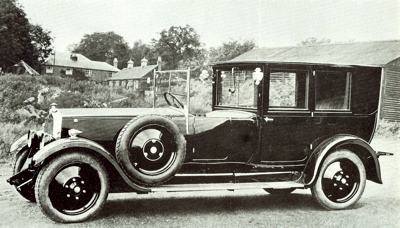 1923 Vanden Plas Brougham. Note the carriage lamps and speaking tube. It was fitted with a Lanchester 21hp chassis.
1923 Vanden Plas Brougham. Note the carriage lamps and speaking tube. It was fitted with a Lanchester 21hp chassis.
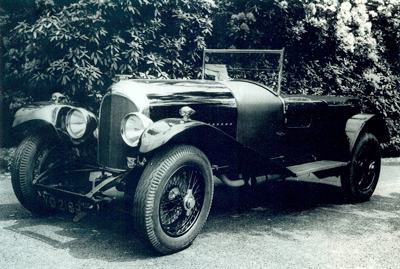 1925 Vanden Plas two-door sports on Bentley 3 liter chassis.
1925 Vanden Plas two-door sports on Bentley 3 liter chassis.
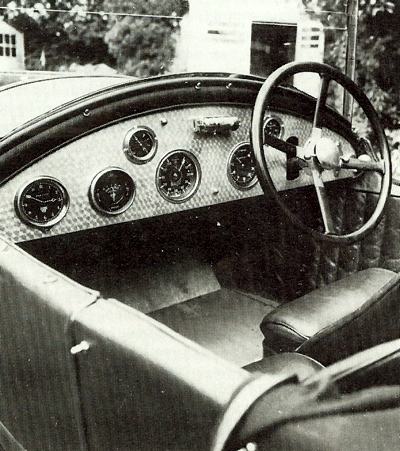 Interior of 1925 Vanden Plas two-door sports on Bentley 3 liter chassis.
Interior of 1925 Vanden Plas two-door sports on Bentley 3 liter chassis.
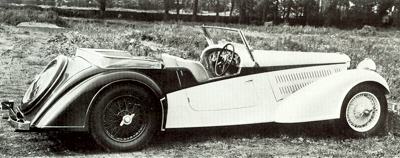 1938 Alvis 4.3 liter tourer with Vanden Plas coachwork.
1938 Alvis 4.3 liter tourer with Vanden Plas coachwork.
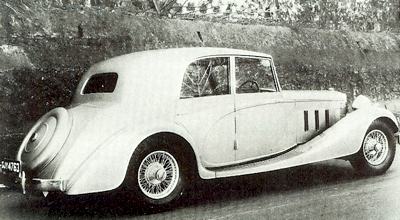 Lanchester Straight 8 with Vanden Plas touring saloon body.
Lanchester Straight 8 with Vanden Plas touring saloon body.
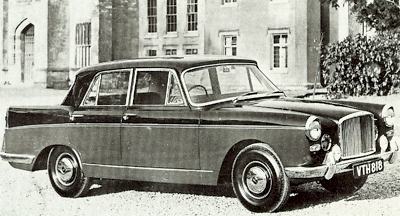 1962 Vanden Plas Princess 3 liter Mk II sedan.
1962 Vanden Plas Princess 3 liter Mk II sedan.
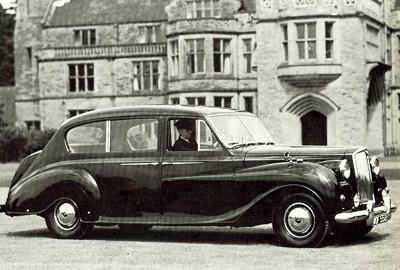 1963 Vanden Plas Princess 4 liter, which was powered by a 3993cc engine.
1963 Vanden Plas Princess 4 liter, which was powered by a 3993cc engine.
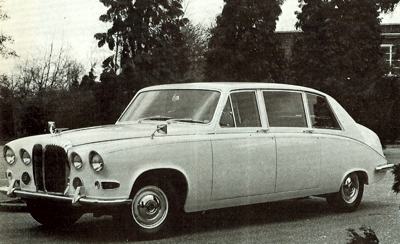 1974 Daimler Limousine with Vanden Plas body, powered by a Jaguar 4.2 liter XK series motor.
1974 Daimler Limousine with Vanden Plas body, powered by a Jaguar 4.2 liter XK series motor.
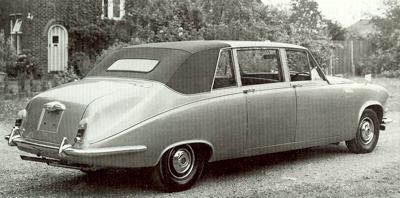 1975 Daimler 4.2 liter Landaulette with coachwork by Vanden Plas.
1975 Daimler 4.2 liter Landaulette with coachwork by Vanden Plas. |
Van den Plas (England) Limited
In 1913, according to reports, the Brussels factory, with a workforce of 850, was turning out 750 bodies a year; this, it seems, was insufficient for Captain Masui's requirements for 'genuine' Van den Plas bodies, as in that year he changed the name of his company to Van den Plas (England) Limited, building Belgian-designed bodies under licence. When war broke out, the Belgian factory was one of the first to be overrun by the invading Germans. As for the British company, this was taken over by the Aircraft Manufacturing Company of Hendon, and became involved in making aeroplanes.
After the war, the Belgium company began operations once again, and in the catalogue for the 1920 Brussel's Salon de I' Automobile, it is recorded that the Carrosseri Van den Plas of 30 Rue Saint-Michel, Woluwe, Bruxelles, were exhibiting 'Automobiles', and that H. Van den Plas was a member of the executive committee of the Chambre Syndicale des Constructeurs d'Automobiles & de Cycles de Belgique. Although the Belgium motor industry was not dead, the changed circumstances of the 1920s had diminished its old markets, and henceforth the focus of attention would be on its moribund English subsidiary, which had busied itself building bodies for the Leyland Eight before AMC's failure.
The Aircraft Manufacturing Company had gone into liquidation as a result of the fall in demand for aircraft after the Armistice; one of the company's managers, Edwin Fox, believed in the potential of a revived British Van den Plas coach-building company, and made an offer of UK£30,000 (most of which would have been borrowed capital) to the company's receivers. The bid was unsuccessful, but there can have been no other offers for AMC, as some considerable time later Edwin Fox acquired the name, goodwill and work in hand for £6000, raised by himself and his two brothers.
Setting up at Kingsbury
Vanden Plas (England) Limited, needed a new factory, and in 1923 acquired Kingsbury Works. The Hyde, Hendon, London NW9, which had been standing empty for some time after the liquidator's stocks of Kingsbury Junior light cars had been cleared following the failure of the Kingsbury Engineering Company in 1921.
Prior to the building of Kingsbury the factory had been operated by the brothers Ernest and Harold Barningham as a manufactory of aircraft parts. The Kingsbury Works, on the edge of Kingsbury aerodrome, was built in the grounds of Kingsbury House, an early Victorian mansion, all of which were purchased by Edwin Fox as Vanden Plas prospered and grew.
The company first exhibited at Olympia in 1924, when they showed a seven-seater limousine on a long-chassis Renault 45 and a 3-liter Bentley saloon. The Renault, upholstered in calfskin and with external trim in sham cane, was over seventeen feet long; the Bentley, which had four-door coachwork had all the bright work silver-plated. A third Vanden Plas body, a sporting open tourer painted ivory white with dark blue wings and chassis was shown on the stand of Bentley Motors Limited; Vanden Plas leased part of the Kingsbury Estate to Bentley, and their coachwork became associated with this marque.
The Cricklewood Bentleys, Cadillac Landaulette and Buick Limousine
Almost a quarter of all Cricklewood Bentleys, including all five Le Mans winners, were bodied by Vanden Plas. Special coachwork was also fitted to other quality chassis such as Delage, Talbot, Daimler and Lanchester. Surprisingly, the Belgian Van den Plas Company was still operating in 1930, although by that time it was building bodies for luxury American chassis. At the 1930 Olympia Show, the company's British agents, Lendrum & Hartman, exhibited an enclosed drive limousine-landaulette de luxe on a sixteen-cylinder Cadiliac chassis ('a very roomy and comfortable carriage for any purpose') and a seven-seater limousine on an eight-cylinder Buick chassis.
At this period, the English company was concentrating on Weymann-type bodies, but by 1931 it seemed that they had reverted to traditional methods of construction. At that year's Olympia Show they exhibited a Talbot 90, a 13 hp Invicta Tourer and a 3-liter Lagonda Coupe. Vanden Plas coachwork was used on the three Talbots which won a Coupe des Alpes in the 1932 International Alpine Trial; as a consequence, a special series of Coupe des Alpes replica bodies was built on Talbot chassis. The 1932 Olympia Show also saw the beginning of an association with Alvis, for which company Vanden Plas manufactured special sporting bodies throughout the 1930s.
It was perhaps not coincidental that Edwin Fox's son Roland, who had studied motor-body engineering at the London Polytechnic before moving to Geneva as a draughtsman with Carrosserie Gangloff, spent most of the 1930s as body engineer with Alvis before becoming Works Director of Van den Plas in 1939. During the war years, Vanden Plas was once again involved in aircraft work, particularly in the construction of the all-wood De Havilland Mosquito. The company had to tool up for large-scale war-time production, and it was felt that this experience should not be wasted when peace came.
A Subsidiary of Austin
Edwin and Roland Fox heard that the Austin Motor Company was looking for a manufacturer for a coach-built sedan body for its new 4-liter chassis. They began discussions which resulted in Vanden Plas becoming a subsidiary of Austin in June 1946. A prototype body was designed, built, accepted without alteration and ready for its public debut at the Geneva Motor Show in March 1947. Known as the Austin AI35 Princess, the model was updated regularly and supplemented from 1952 by a long-wheelbase limousine version.
Edwin Fox died in 1954 and his son became Managing Director. Four years later, Vanden Plas became a marque in its own right, the name being used not only for the big saloons and limousines but also for luxury versions of the Austin A99/AIIo series and the 1100, these models being superseded by the 4-liter Rolls-Royce engined Rand 1300 respectively.
In 1974, the Princess name was dropped from Vanden Plas nomenclature with the announcement of the Vanden Plas 1500, a luxury version of the Austin Allegro. At the same time, Roland Fox retired (although continuing to act in an advisory capacity for the company) and was succeeded by W. H. Peel, who had been with Vanden Plas since 1946.
The Daimler Xl Double-Six
However, the Vanden Plas name was still associated with luxury limousines, their 1975 offering in this field being a special super-luxury version of the Daimler Xl Double-six and the Limousine. The landaulette version of the Daimler Limousine could cost up to UK£15,000, and the complex linkage of the folding roof could involve some 300 hours of building and adjustment by craftsmen. After the demise of Austin the Vanden Plas name ended up with the Rover Group, and Jaguar was forced to stop using it in the United Kingdom, though it continued to do so in America.
The Daimler Double-Six Vanden Plas became, simply, the Daimler Double Six, and the Sovereign designation was transferred to Jaguar. Jaguar was subsequently acquired by Ford as were the North American rights. Production of the Vanden Plas Princess limousine stopped in 1968 when Jaguar introduced the Daimler DS420 Limousine (Jaguar had acquired Daimler in 1960). The DS420 was produced at the Kingsbury Lane Vanden Plas factory until it closed in November 1979.
Placed on Jaguar models the Vanden Plas label still signifies Jaguar's most luxurious variant. In addition, Jaguar uses the Vanden Plas name in markets where, for licensing reasons connected with the former DaimlerChrysler, the Daimler name cannot be used. These include the United States and some Middle East countries.
The last British car to have the Vanden Plas name was the Rover 75. The rights to the design of the Rover 75 cars and the MG Group were purchased by a Chinese firm, Nanjing Automobile. Ford purchased the Rover name from BMW to protect the Land Rover name from Shanghai Automotive who wanted the brand. The Vanden Plas name (for outside North America) and many other Leyland names were purchased by Nanjing Automobile.
Also see:
Vanden Plas Car Reviews 